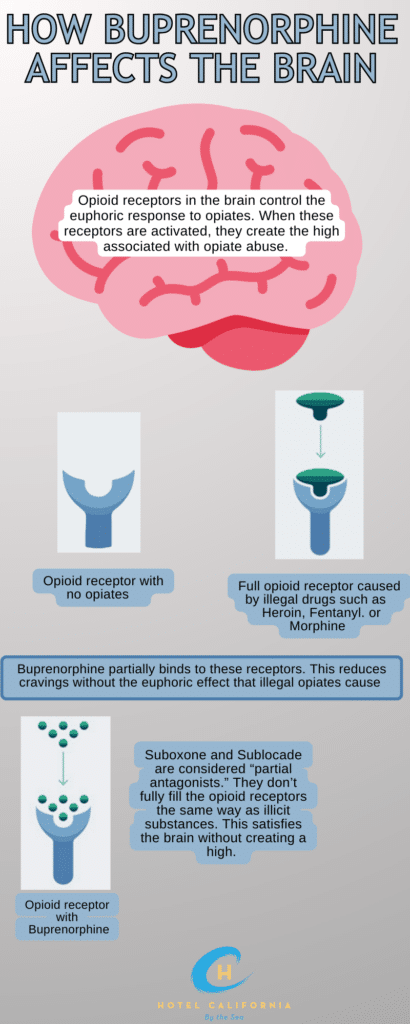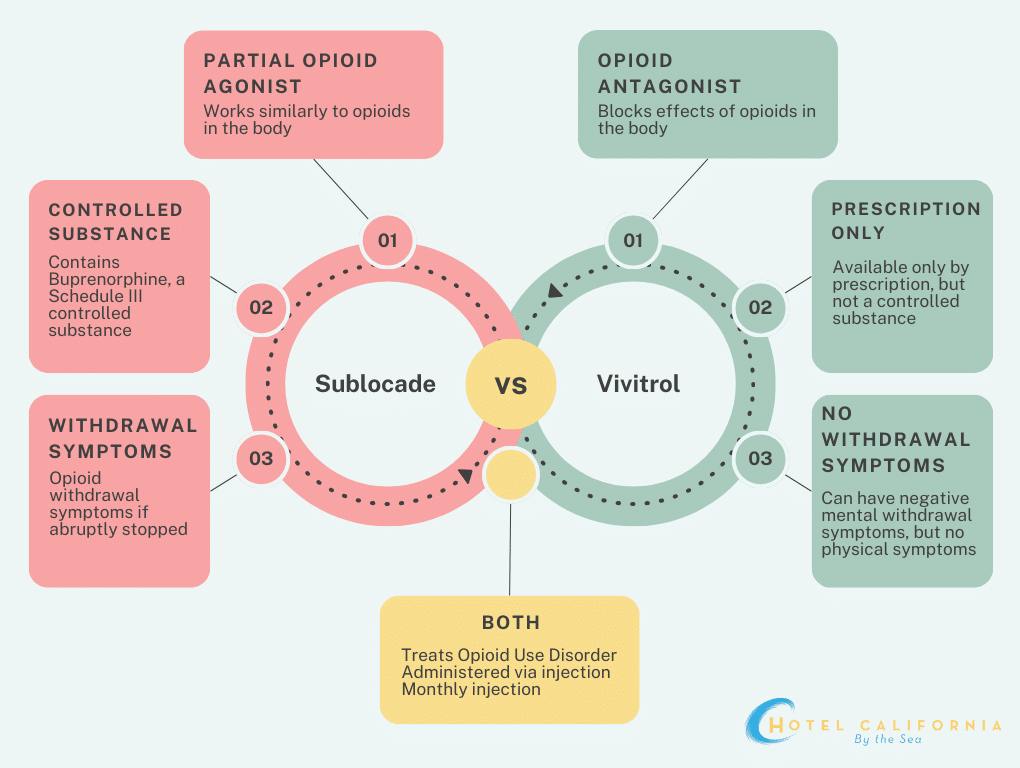Drug Comparison: Sublocade vs Vivitrol
Opioid use disorder has become a growing epidemic in the US for decades. Two common forms of medication treatment include Sublocade and Vivitrol. According to the American Society of Addiction Medication and the Substance Abuse and Mental Health Services Administration, both drugs are effective for long-term medication management of opioid use disorder. Both drugs are administered as injections after detox and withdrawal during the maintenance phase of treatment to help lessen opioid cravings. What is Sublocade and Vivitrol? What is the difference between Sublocade vs Vivitrol?

Both Sublocade and Vivitrol are brand-name injectable medications used in the treatment of opioid use disorder. The long-acting medications were approved for opioid use disorder treatment by the FDA in 2017. However, the drugs cannot be used together. If they are used together, the active ingredients in Vivitrol will block the effects of Sublocade and can cause a person to go into withdrawal. The medications do not reverse overdose and are primarily administered during the maintenance phase of recovery treatment to help lessen cravings in those with severe opioid addictions.

Sublocade vs Vivitrol
Sublocade
- Contains the active ingredient buprenorphine which eases withdrawal symptoms to help maintain abstinence.
- Partial opioid agonist – works similarly to the opioid receptors in your body.
- The average cost is about $1,829 per month.
- Prescription subdermal injectables are administered once a month as part of long-term medication management. It must be properly injected to avoid any veins so self-injection is not recommended. The injection forms a gel patch under the skin called a depot. It turns into a solid little bump under the skin. It gradually releases buprenorphine into the body over a period of about 28 days.
- Before beginning injection treatments, users must take a buprenorphine film that dissolves under the tongue or inside of the cheek seven days before beginning Sublocade treatment.
- Side effects include constipation, headache, itching, nausea, vomiting, liver problems and low blood pressure.
- Half-life is 43-60 days
- There is a moderate potential for abuse when taking Sublocade. Buprenorphine is a weaker opioid that stays in the body for a long period of time. Tolerance and dependence can develop and with that so can the experience of withdrawal. Withdrawal symptoms can include anxiety, nausea, vomiting, muscle aches and trouble sleeping.
Vivitrol
- Contains the active ingredient naltrexone.
- Opioid antagonist – works by completely blocking the effects of opioids including substances that contain buprenorphine. It blocks the euphoric and pain relief properties produced by opioids. The body must be free of all opioids at least seven days before the start of treatment or the user will begin experiencing opioid withdrawals.
- The average cost is about $2000 per month.
- Vivitrol is also used in treatment for alcohol use disorder to help reduce cravings after the detox and withdrawal phase. It blocks the intoxication and euphoric high produced by alcohol. The lack of the reinforced high cause the brain to lose interest in alcohol and help lessen cravings.
- Prescription intramuscular injectable is administered into the muscles. It is a monthly medication. It is sometimes preferred over Sublocade because it contains no addictive properties, no potential for overdose and does not cause withdrawal when medication is stopped.
- Not as effective in reducing physical and psychological opioid cravings.
- Side effects include symptoms of the common cold, headache, high blood pressure, itching, sleep disturbances, depression and suicidal thoughts, liver problems and pneumonia.
- Half-life is about 5-10 days
- Vivitrol completely removes opioids from the body and reduces the level of opioid tolerance back to zero.

The use of medication for the treatment of Substance Use Disorders
Substance use disorder along with addiction to other mind-altering substances are considered mental illness diseases. Experts in treatment have determined that pharmacology and medication can play an effective role in the treatment and relapse prevention of the disease. They have mostly been used as an adjunct to cognitive and behavioral therapies. Over the past 30 years, research and studies have developed more effective medications to help treat substance addictions.
These FDA-approved medications work in various aspects of addiction treatment. They work to improve patient survival and prevent relapse. They work to increase retention in treatment, which helps more patients reach recovery. They work to decrease illicit drug use including opioids and alcohol. And they work to increase a patient’s ability to heal from physical and psychological damage inflicted by substance addiction.
Today substance use disorder pharmacological treatments have three main objectives; management of acute withdrawal symptoms through detox, the reduction of cravings to use illicit and mind-altering drugs, and the relapse prevention of dangerous drug-using behaviors.
Check Your Insurance Coverage for FREE
Find out if your insurance covers addiction treatment in minutes. We accept most insurance!
There are also three main types of medications used to help treat various substance use disorders: full agonist medications, partial agonist medications and antagonist medications. Full agonist medications work by directly stimulating the opioid receptor sites in the brain and are often used as a replacement for abused drugs. It is often prescribed as part of long-term medication therapy. Partial agonist medications are often used during the detox phase of treatment. It also works to maintain abstinence and reduce the risk of relapse and physical dependence. Antagonist medications work by binding to the opioid receptors without stimulating any of the pain relief or euphoric effects.
Common medications used to treat various Substance Abuse Disorders
MAUD – Medications for Alcohol Use Disorder
- Acamprosate
- Disulfiram
- Naltrexone
MOUD – Medications for Opioid Use Disorder
- Buprenorphine
- Methadone
- Naltrexone
Reach out to Hotel California by the Sea
We specialize in treating addiction and other co-occurring disorders, such as PTSD. Our Admissions specialists are available to walk you through the best options for treating your addiction.
Treatment for Opioid Use Disorder
There is no pharmacological cure for opioid use disorder or any substance use disorder. Medications such as Sublocade and Vivitrol work to treat symptoms to help alleviate recovery and maintain abstinence. Research and studies have shown that medication in combination with behavioral therapies, can provide patients with a solid path to ongoing recovery. These medications work to normalize brain chemistry, block the euphoric effects produced by the addicted drug, relieve psychological cravings and normalize body functions.
At Hotel California by the Sea, we provide a “whole patient” approach to the treatment of substance use disorders such as opioid addiction. Our recovery program provides different levels of care to address patients at their level of recovery. Our rehab contains detox treatments, residential inpatient and various outpatient programs. We believe in the combined powers of both pharmacological treatments as well as cognitive treatments. We use evidence-based methods such as CBT, family therapy and group therapy as part of individualized treatment care.
Hotel California by the Sea provides the tools, resources and support clients need to reach and maintain drug abstinence. We provide individualized treatment plans and treat substance use disorders as well as any co-occurring mental health conditions. Let us help you overcome your addiction.
References:
https://www.ncbi.nlm.nih.gov/pmc/articles/PMC3767185/
https://psychgarden.com/vivitrol-vs-suboxone-weighing-the-choices/
https://www.bicyclehealth.com/opioid-education/sublocade-vs-vivitrol
https://www.samhsa.gov/medications-substance-use-disorders
https://www.healthline.com/health/drugs/sublocade#_noHeaderPrefixedContent
https://www.dayamentalhealthandwellness.com/services-1
https://www.drugs.com/compare/sublocade-vs-vivitrol
https://www.healthline.com/health/drugs/sublocade-vs-vivitrol#:~:text=Both%20drugs%20are%20used%20as,muscle%20by%20a%20healthcare%20provider
